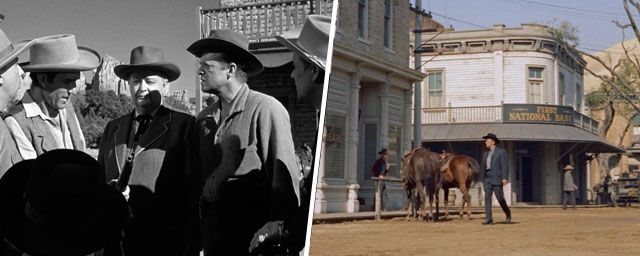The Last Train from Gun Hill is often seen as a minor western in that it would only be a pale commercial and opportunistic copy of another western, 3:10 for Yuma. What if it was a little more complicated than that?
We are January 27, 1960 and Gun Hill’s Last Train is released on French screens. Worn by Kirk Douglas and Anthony Quinn, this western is co-produced by Douglas and directed by John Sturges, with whom the actor recently filmed Settlement of Accounts at OK Corral. Still, the film received mixed reviews, particularly due to suspicions of plagiarism.
Gun Hill presents the adventure of Sheriff Matt Morgan (Douglas), who has sworn to find those who killed and murdered his wife. Leading the investigation, he discovers that one of them is the son of his old friend Craig Belden (Quinn). But he refuses to deliver it. Except that nothing will stop Morgan in his quest for justice.
Some critics, including the authors of the reference work 50 years of American cinema are quite severe with The Last Train from Gun Hill, criticizing it in particular for the proximity of its plot to that of another western: 3:10 for Yuma, released three years earlier, judging that it is only a “marked out[e] shameless” of Yuma.
Directed by Delmer Daves, 3:10 for Yuma tops the bill with Glenn Ford and Van Heflin. And it must be recognized that it has several points in common with the events of Gun Hill, because in both cases:

Columbia Pictures/Paramount Pictures
Prisoners Earl Holliman of “Last Train” and Glenn Ford of “3:10”
- The hero must lead an outlaw from point A to point B.
- This journey ultimately requires boarding a train which we must nervously wait for departure.
- Bandits seek to free the outlaw.
- The hero seems alone against all.
- A key scene in the film shows the hero waiting locked up in a hotel room with his prisoner.
Admittedly, the list is troubling. However, the scripts are adapted from different sources: a story by Elmore Leonard for Gun Hill, and the novel Showdown of Les Crutchfields for Yuma. But it must be added that there are enormous differences between the two westerns and their treatment of the same situation.
Yuma is above all a psychological western, as was increasingly the case in the 1950s. The most commonly cited example being The Train Will Whistle Three Times. The idea of these films was to bring new themes to a genre often reduced to gunfights between bandits or bluecoats against Indians.
The psychological aspect of Yuma appears on the screen in particular through the discussion in the hotel room between the hero and the bandit, the latter insinuating doubt into the mind of Van Heflin’s character and trying to make him crack.
On the other hand, in Gun Hill, the spectator finds himself more in a tragedy, with a more caricatural villain, less fine and of much more “nondescript” appearance. The important thing is rather his conflicting relationship with his father, played by Anthony Quinn, and the opposition between two friends because the son of one killed the wife of the other. The conclusion of the two films, which we will not reveal here, is also very different.

Columbia Pictures/Paramount Pictures
The oppressive crowd / The loneliness of the hero
Finally, the two films differ radically in their staging. Yuma chooses an oppressive direction by filling the frame with close-up faces or placing several protagonists hugging each other, reinforcing a sense of suffocation felt by both hero and viewer.
Gun Hill opts for the exact opposite, losing the characters in the frame to better show the disarray of the lawyer alone to accomplish his perilous mission and the loneliness of each of the protagonists, tormented by their confrontations.
For all these reasons, it appears that rather than opposing Gun Hill and Yuma, it is possible to embrace their common canvas to better appreciate their radical visual and narrative differences. Perhaps Sturges’ film is only a partial 3:10 “plagiarism” for Yuma, but it obviously has its own tone, very different characters and another purpose and for that, deserves to be rediscovered but also no doubt reassessed.
Watch our special video dismantling clichés about the western genre:
